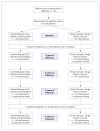Clinical Performance of Direct Composite Restorations in Patients with Amelogenesis Imperfecta - Anterior Restorations
- PMID: 35322945
- PMCID: PMC11734318
- DOI: 10.3290/j.jad.b2838105
Clinical Performance of Direct Composite Restorations in Patients with Amelogenesis Imperfecta - Anterior Restorations
Abstract
Purpose: To evaluate the clinical performance of direct composite restorations using nanohybrid and nanofill composite materials in anterior teeth in patients with amelogenesis imperfecta (AI).
Materials and methods: The study included 15 patients with AI aged 14-30 years. During the study, the patients received anterior direct composite laminate veneer restorations using either a nanohybrid (Clearfil Majesty ES-2 and Clearfil Universal Bond, Kuraray Noritake) or a nanofill resin composite (Filtek Ultimate Universal Restorative and Single Bond Universal Adhesive, 3M Oral Care). The restorations were evaluated according to the modified USPHS criteria at baseline and at 1-, 2-, 3- and 4-year follow-up periods.
Results: The cumulative success rate of anterior restorations was 80.5% for nanohybrid and 92.5% for nanofill composite after 4 years. Eight restorations with nanohybrid and three restorations with nanofill resin composites failed. Ten restorations failed due to fracture; the fracture rate was 12.3%. Statistically significant differences were found between nanohybrid and nanofill composites regarding marginal discoloration and surface texture after 3 years. Furthermore, statistically significant differences were observed with respect to color match after 4 years.
Conclusion: The use of a nanohybrid or nanofill composite for anterior direct restorations in patients with AI was observed to be satisfactory, based on the rate of ideal and clinically acceptable restorations. The primary reason for restoration failure was fracture. The failure rate of nanohybrid composite restorations was higher than with nanofill composite restorations with respect to survival and marginal adaptation criteria.
Keywords: amelogenesis imperfecta; composite resin; dental enamel; dental restoration; prospective study.
Figures




Similar articles
-
Clinical Performance of Direct Posterior Composite Restorations in Patients with Amelogenesis Imperfecta.Oper Dent. 2022 Nov 1;47(6):620-629. doi: 10.2341/21-106-C. Oper Dent. 2022. PMID: 36281978
-
Clinical Performance of Direct Posterior Composite Restorations in Patients with Amelogenesis Imperfecta.Oper Dent. 2022 Oct 21. doi: 10.2342/21-106-C. Online ahead of print. Oper Dent. 2022. PMID: 36279361
-
Two-year clinical evaluation of ormocer, nanohybrid and nanofill composite restorative systems in posterior teeth.J Adhes Dent. 2008 Aug;10(4):315-22. J Adhes Dent. 2008. PMID: 18792703 Clinical Trial.
-
Restorative Treatment in Patients with Amelogenesis Imperfecta: A Review.J Prosthodont. 2018 Aug;27(7):618-623. doi: 10.1111/jopr.12736. Epub 2018 Jan 29. J Prosthodont. 2018. PMID: 29377372 Review.
-
Quality and Survival of Direct Light-Activated Composite Resin Restorations in Posterior Teeth: A 5- to 20-Year Retrospective Longitudinal Study.J Prosthodont. 2019 Jan;28(1):e195-e203. doi: 10.1111/jopr.12630. Epub 2017 May 17. J Prosthodont. 2019. PMID: 28513897 Review.
Cited by
-
Clinical Survival Rate and Laboratory Failure of Dental Veneers: A Narrative Literature Review.J Funct Biomater. 2024 May 16;15(5):131. doi: 10.3390/jfb15050131. J Funct Biomater. 2024. PMID: 38786642 Free PMC article. Review.
References
-
- Akin H, Tasveren S, Yeler DY. Interdisciplinary approach to treating a patient with amelogenesis imperfecta: a clinical report. J Esthet Restor Dent. 2007;19:131–135. discussion 136. - PubMed
-
- Barnes DM, Blank LW, Gingell JC, Gilner PP. A clinical evaluation of a resin-modified. Glass ionomer restorative material. J Am Dent Assoc. 1995;126:1245–1253. - PubMed
MeSH terms
LinkOut - more resources
Full Text Sources

